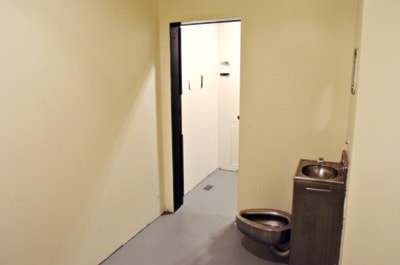After three months in segregation, Michael Nehass was moved to a cellblock on Tuesday.
Five minutes later, he was back in The Hole.
Last week, Nehass received a memo from jail staff stating he would be moved to the new cellblock (NCB) from 10 a.m. to 2 p.m. daily, he said.
Tuesday was the first day.
He wasn’t moved until 1:30 p.m.
“And I had yard in that half hour, so I only was in NCB for five minutes,” said Nehass.
The Hole was empty during a jail tour conducted just after 1 p.m. on Wednesday.
Nehass is not in segregation anymore, said jail acting program manager Mark Daniels.
However, in the concrete bunker known as ‘Seg. One’ there was a pair of rubber sandals, books, papers and an open bag of trail mix.
The cot still had rumpled sheets and a blanket on it.
Officials banned any photographs of the cell.
Daniels would not say if Nehass was coming back.
“That depends,” he said.
The windowless room was dim, stuffy and grimy.
In one corner, there was a video camera sealed up behind dirty glass.
The sink and toilet was one unit.
The second segregation cell didn’t even have a cot, just a thin rubber mat on the floor.
Photographs of this empty cell were permitted, but prison officials removed the well-worn mat first.
It’s unusual to not have TVs in segregation, said West Coast Prison Justice Society lawyer Mark Redgwell.
“These guys are locked up in this tiny room and don’t even have an idiot box to distract them,” he said.
“You can only read so much, and some guys are illiterate.
“It’s crazy — I think it’s inhumane.”
If both units are occupied, the prisoners can call back and forth through the barred doors, said Daniels.
But they can’t see each other.
Thursday morning, during a second visit to the facility the News overheard guards radioing to move a prisoner from Seg. One.
Nehass is no longer in segregation, said Justice spokesperson Dan Cable on Thursday afternoon.
He could not say when Nehass was moved.
“Recently,” said Cable.
In the Yukon’s Corrections Act it states: “Upon receiving a report of any serious matter … the director may make one or more of the following awards … b) confinement in segregation for a period not exceeding 15 days, with or without restricted diet.”
The act was last reviewed in 1973.
Often, to get around time restrictions laid out in the act, prisoners will be taken out of segregation for just a few hours, said Redgwell.
“There are always loopholes,” he said.
The Yukon’s “Draconian” Corrections Act surprised Redgwell.
There’s a section on how to deal with prisoners on death row, a section that allows prison officials to shave prisoners’ hair and a clause that suggests punishment by restricting diet.
“Restricting diet — that’s cruel and unusual punishment,” said Redgwell.
“What do they feed them — bread and water?”
“We don’t do that anymore,” said Daniels.
And prisoners don’t get their hair shaved unless they request it, he said.
The death penalty hasn’t been around since 1976, added Justice spokesperson Dan Cable.
Those sections of the act just lapse, he said.
Nehass, who felt he was being unjustly held in The Hole, tried to make an official complaint after his first month in solitary, he said.
“Usually complaints go through an outside office that deals with the ombudsman and the ombudsman talks to Ottawa,” said Nehass, who has spent time in a federal penitentiary.
“And they have that here, but here the ombudsman works with the institution.
“And they don’t listen to the inmates.”
Nehass hasn’t been able to talk with the ombudsman, he said.
“The spokesperson for the ombudsman won’t let me talk to her,” said Nehass.
“They say they are doing an investigation, but no investigation has been held.
“For the last two months I have been trying to speak to the ombudsman.”
In BC, prisoners who submit a complaint should have a response within seven days, said Redgwell.
“The advantage of BC’s complaint process, and the federal process, is it’s clearly set out how it’s supposed to work.
“I don’t know how it’s set out in the Yukon, it’s not clear.”
Tracy McPhee, the Yukon’s ombudsman, is away and could not be reached for comment.
